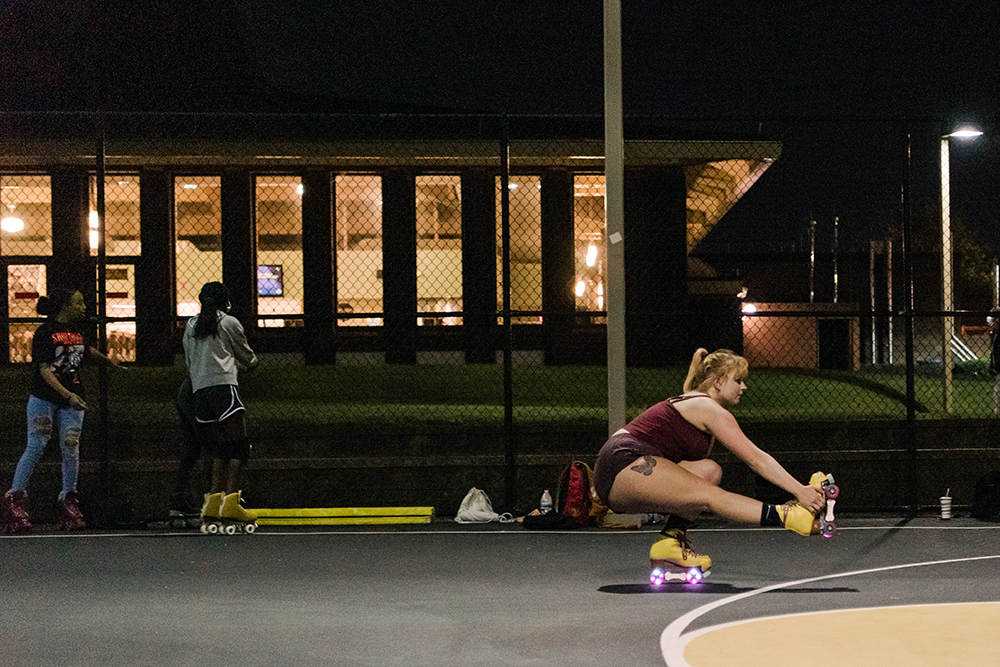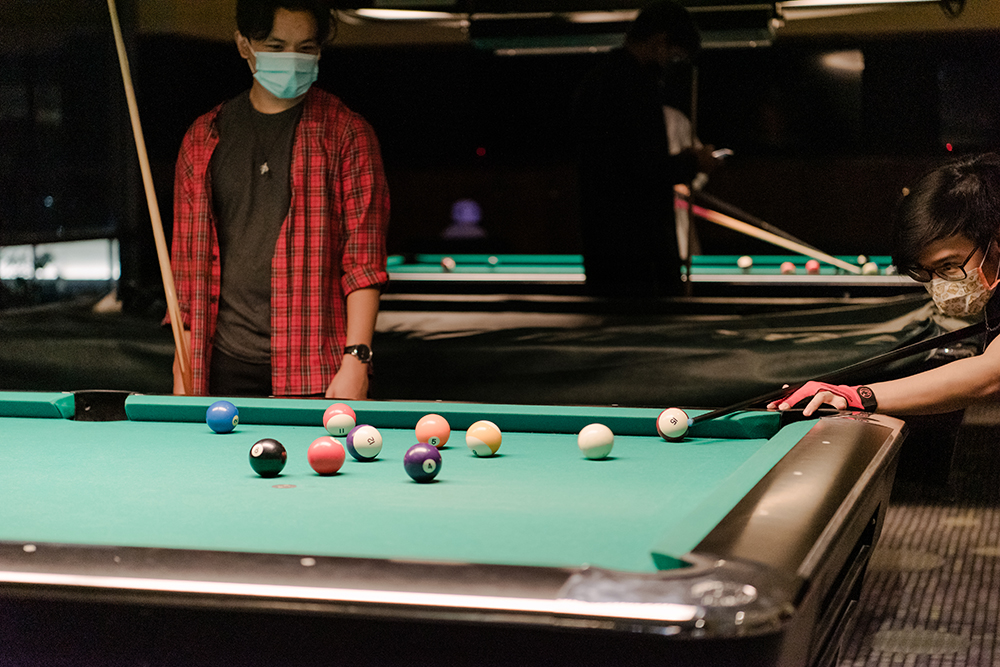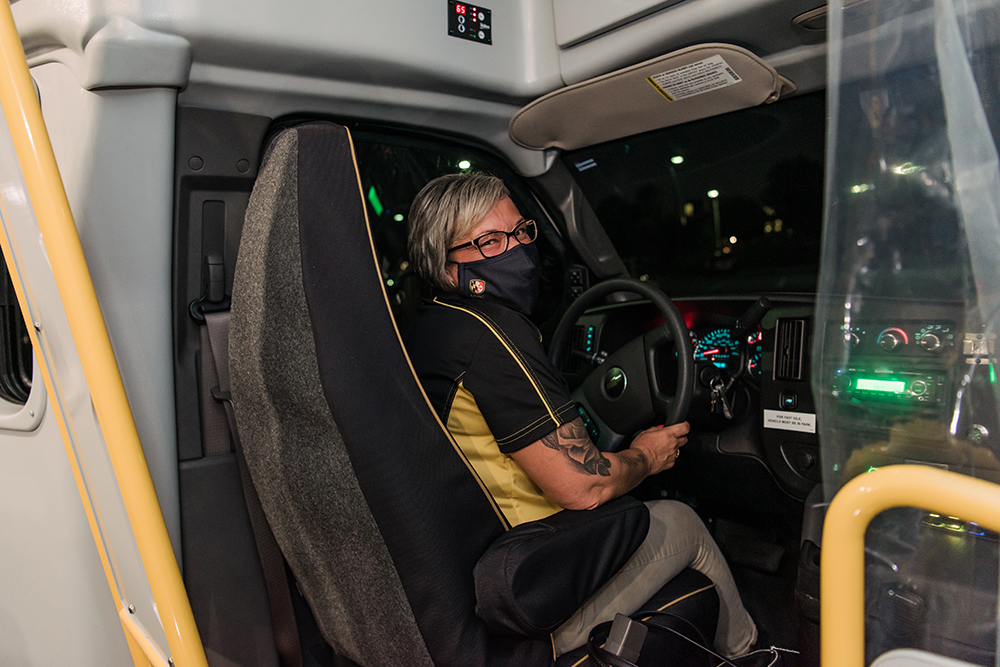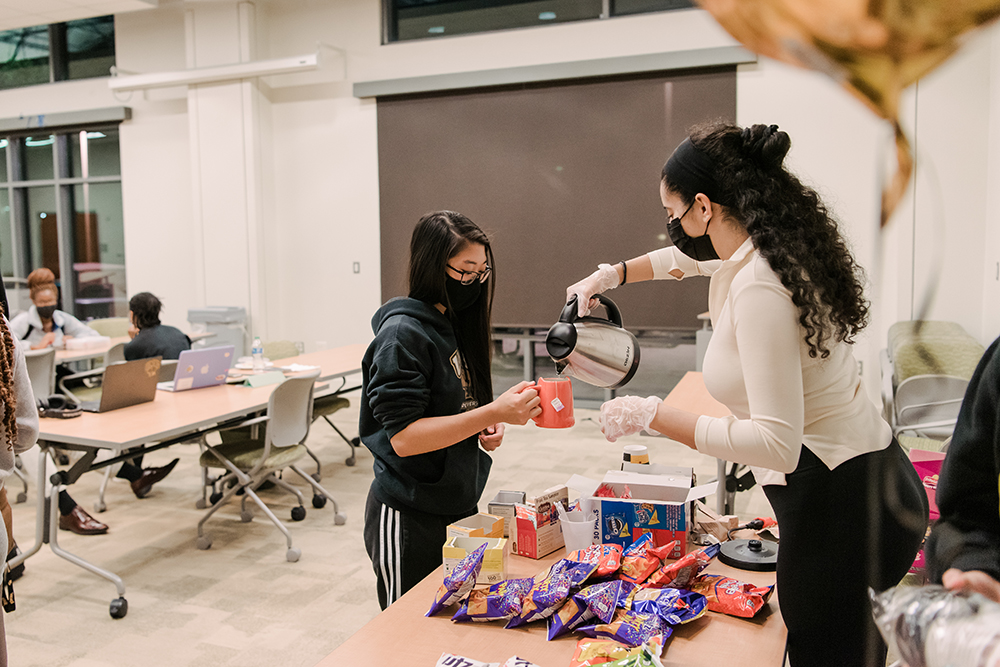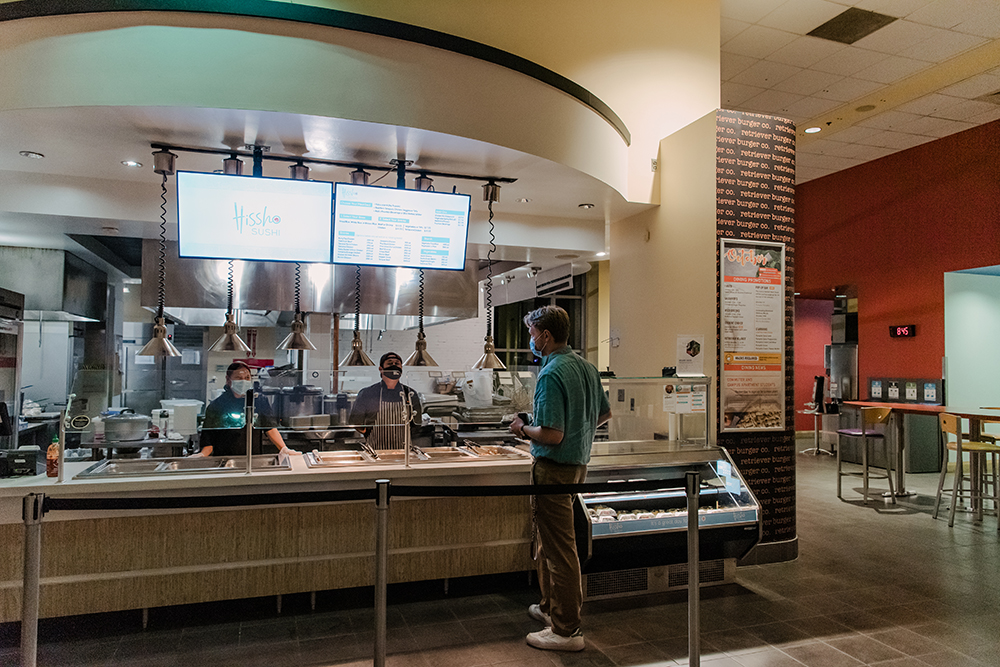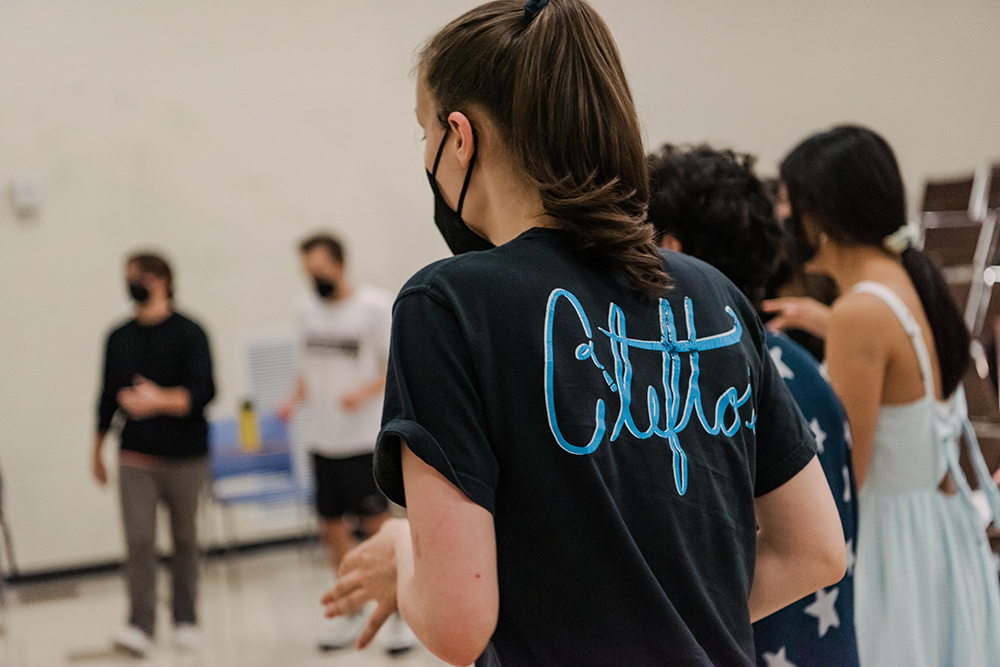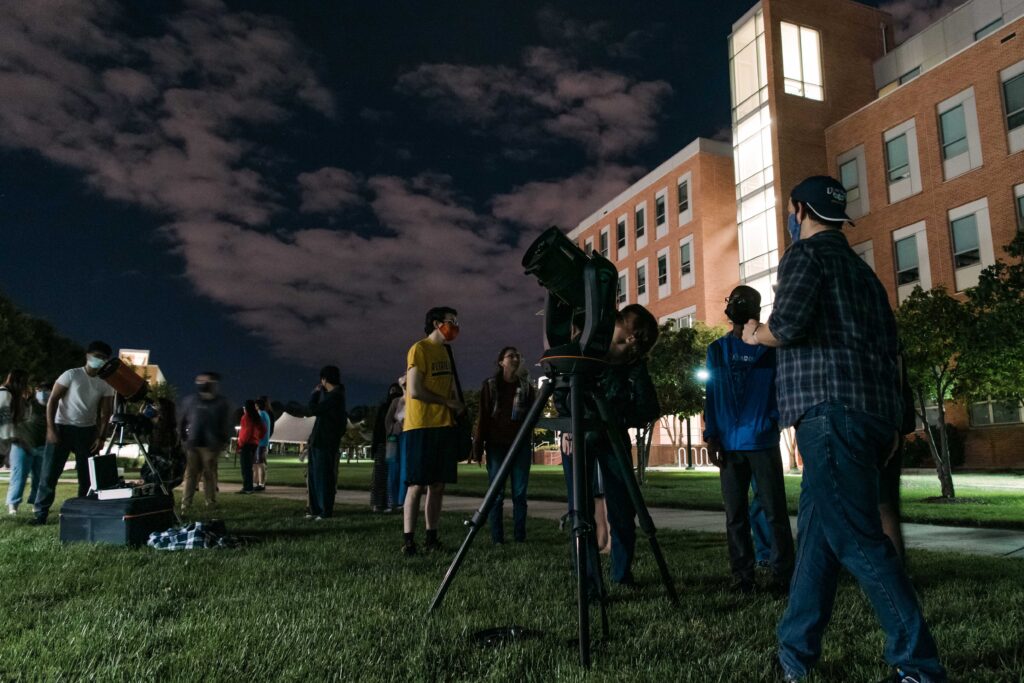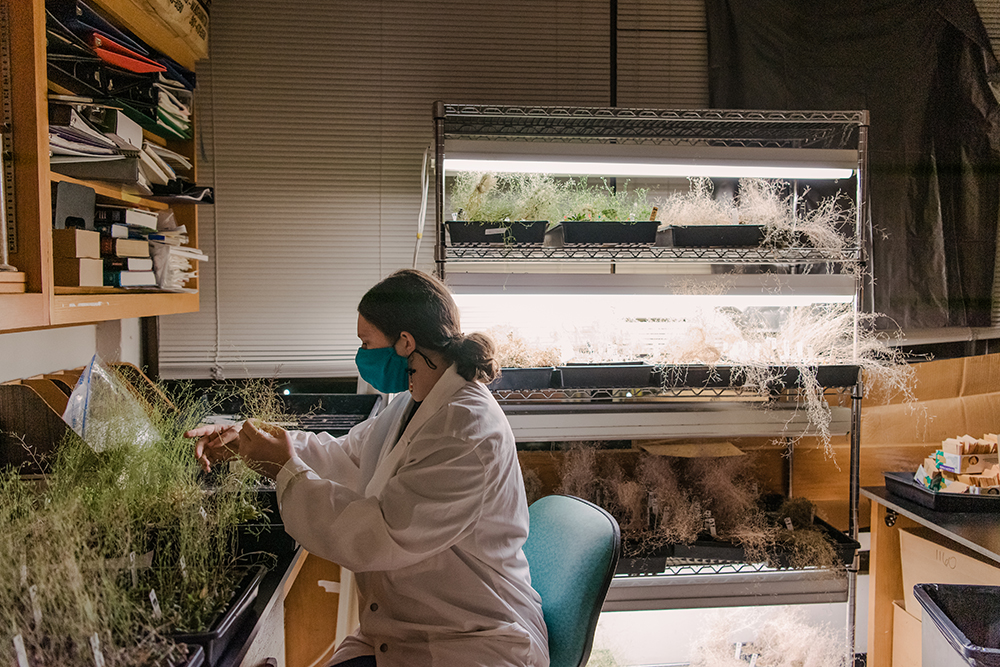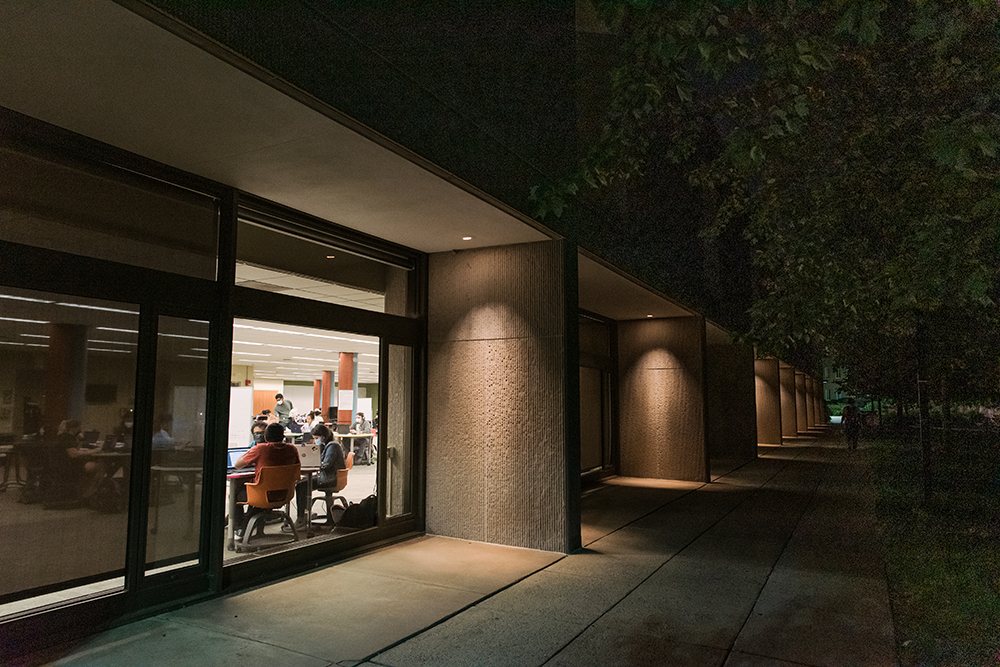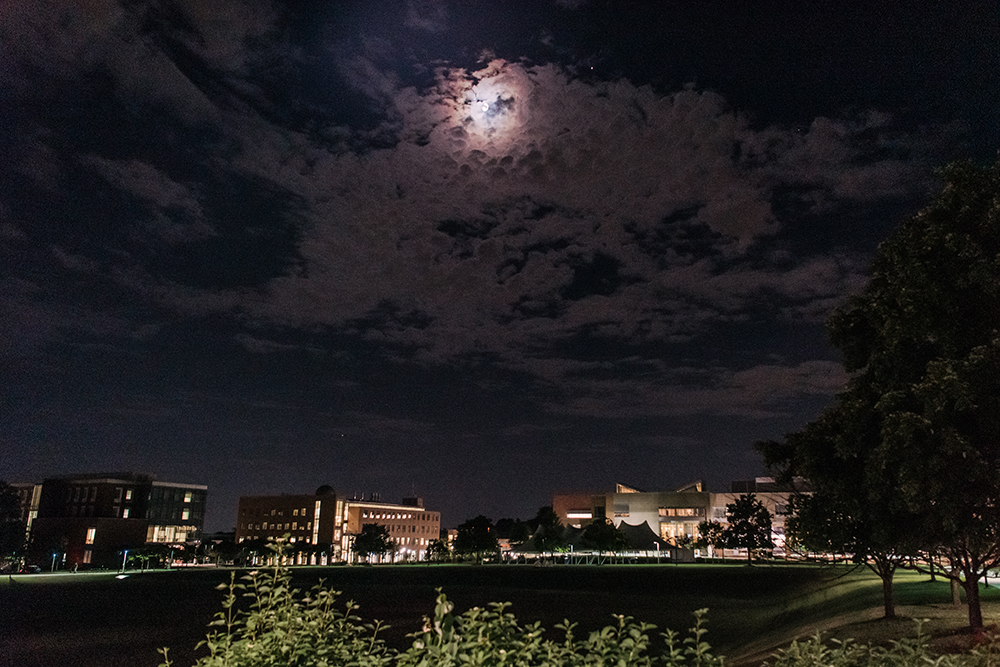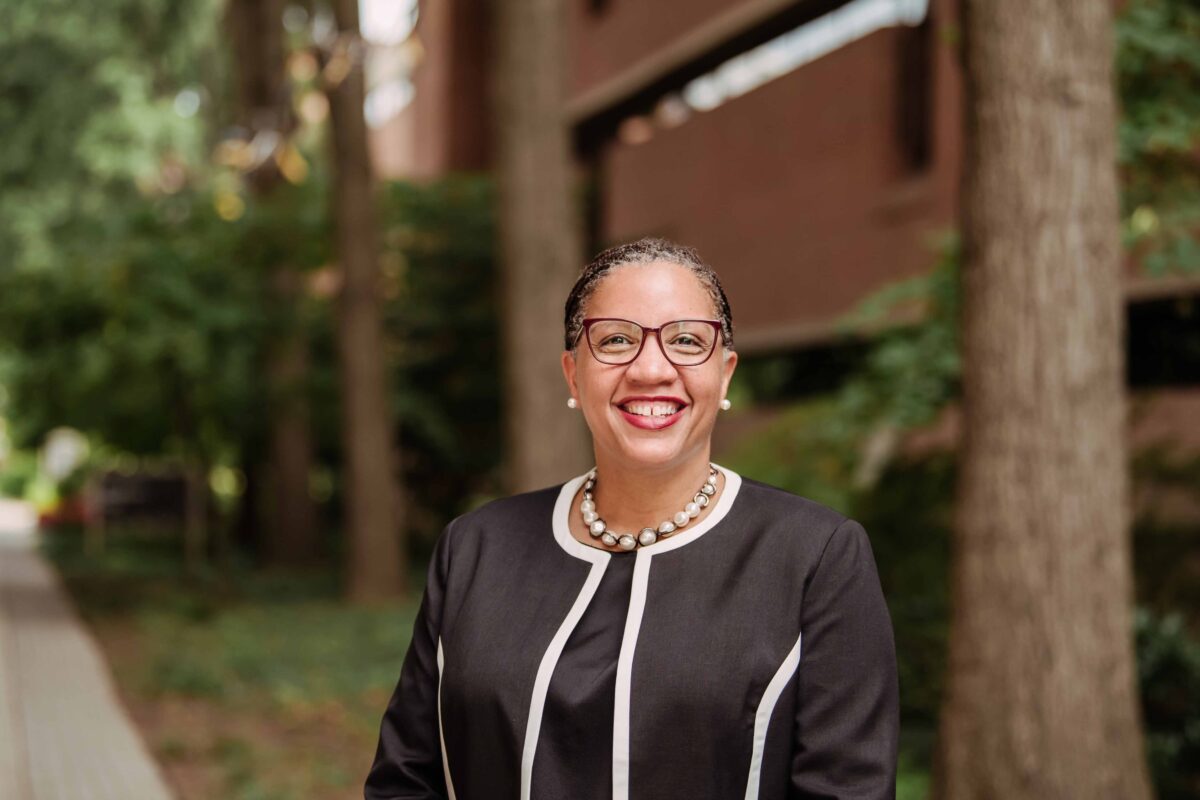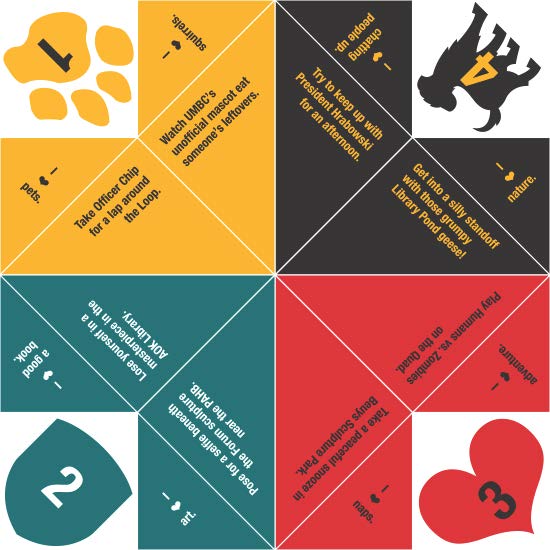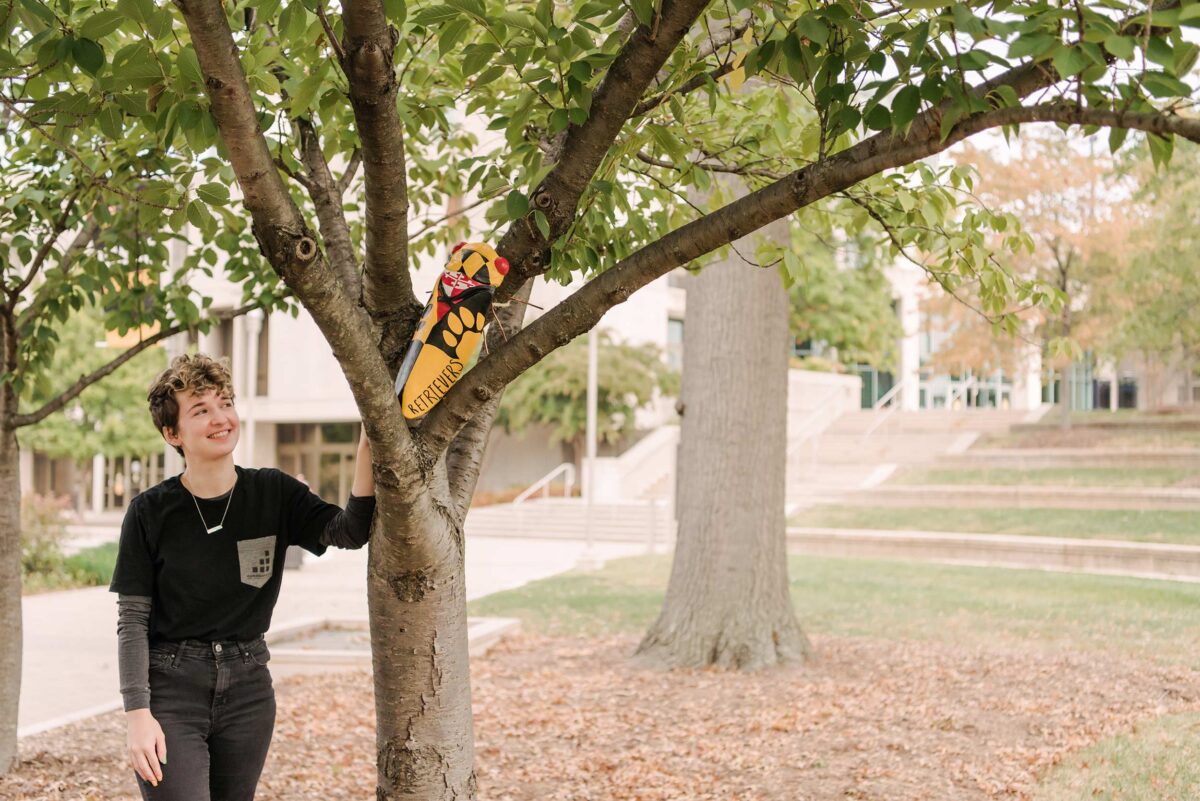Life doesn’t pause when classes end and the sun goes down. Instead, students grab a cup of coffee and find a million ways to follow their interests. Whether dancing, studying over pizza, or keeping delicate plants alive in the labs—our campus is abuzz 24/7. We sent staff writer Charis Lawson ’20 and editorial interns Anna Lee ’22 and Eric Widemann ’21 off into the night with UMBC Magazine photographer Marlayna Demond ’11 to explore it all.
Especially in the Dark, UMBC Rolls On
D-Hall Basketball Court
Every evening from 8 p.m. to 2 a.m., steady streams of students fill the dining hall at True Grit’s Late Night. Some come strictly for the food, others to socialize. Some come for a study break, others come to study.
Just outside the dining hall, an entirely different scene presents itself. Playful shouts radiate from the basketball court. As night arrives, so does cool, crisp air—but students have found a way to keep warm by engaging in a hotly contested pick-up basketball game. This happens here almost every night.
But tonight, something else is particularly eye-catching. Whizzing just above the ground, the wheels of roller skates radiate bright rainbow colors, and laughter and chatter follow the lights much in the way that sound usually follows light.
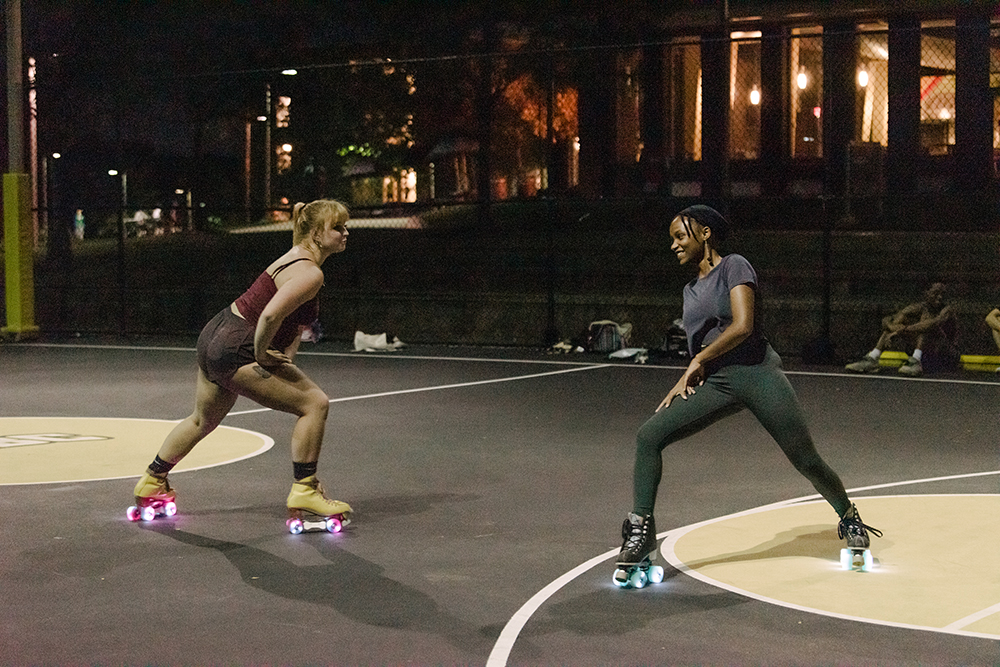
“I roller skate on campus every single day, as often as I can, sometimes even to or in class,” says Maddie Mills-Snyder ’25, undecided, AKA “Rex” to the thousands of followers of her roller skating-centric Instagram.
Skating after dark presents a unique opportunity “because that’s when we get to skate to late night with our light-up wheels,” says Mills-Snyder, sharing the court with Leah Jupiter ’25, biology, who loves the energy and cool breezes of nighttime skating.
“I love learning new tricks and showing off. I love when people ask us to show them a trick. Rex and I have also created a few dances to popular songs like ‘Bad’ by Michael Jackson,” continues Jupiter. Both love this court but also take advantage of any flat surface, really—the Commons garage, or elsewhere around campus.
Both agreed the best part of skating is the community it brings. So if you’re looking to light up the night on campus, lace up your skates and you’ll be sure to find a welcoming scene.
“I love empowering other skaters,” says Mills-Snyder.
– Eric Widemann ’21
Run for Your Life
Campus-wide
All across campus, darkness camouflages hoards of young adults chasing one another and defending themselves with Nerf darts and rolled-up socks. If that sounds like a childish game, Humans vs. Zombies (HvZ) members would agree with you. HvZ members are not known for taking themselves seriously.

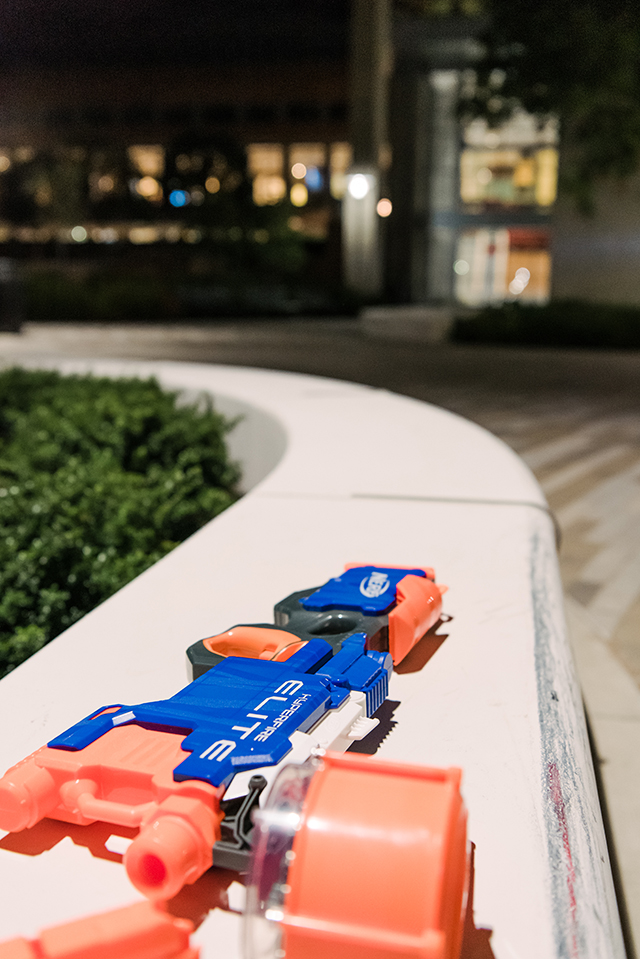
While many members have described HvZ as a glorified game of tag, there is a lot more to it than that, the members explain. “An average mission starts with a briefing where we learn about our mission and what we’re expected to do in order to win. Most people start ‘human’ but some start ‘zombie.’ Humans start strong and more often than not, human victory feels like it’ll be a piece of cake,” notes Henry Denny ’23, mechanical engineering. Usually, the humans have to rethink that sentiment as the hoard of zombies grows.
HvZ has a decade-long legacy on campus, organizing night missions, Saturday games, missions that span across other colleges, and even week-long missions that run 24/7. The result? A tight-knit community like no other. Kyle Mosier ’20, computer science and mathematics, M.S. ’22 computer science talks about how during the pandemic, having a group of friends to eat with several times a day on campus was so important.
Even after the missions are complete, it doesn’t mean everything is over. They often head over to D-Hall (as their human selves, not their zombie selves) for non-brain-related snacks and to tell stories from the night and club lore, stories that have been passed down from years ago.
– Charis Lawson ’20
Bringing Your A-Game
UMBC Game Room
Whoever controls the playlist in the Game Room has queued a selection of upbeat songs, only rivaled in volume by the smacking of billiard balls and rhythmic bouncing coming from the pingpong tables.
Tonight, more or less every billiards table is in use, and the pingpong tables are playing host to some intense rallies. Ayush Nigam ’24, computer science, plays pingpong or billiards two to three times a week and enjoys the “dark-ish warm vibe” of the space after hours.
Justin Nguyen ’24, biochemistry, is among the gamers, as he is many nights of the week. Around him, enthusiastic players of all sorts blow off steam with their favorite video games or practice their angles on the pool tables.
“Whenever my friends and I come [here], it’s to play pingpong. We love the competitiveness– it gets the blood flowing,” he continues. “I love hanging out with friends.”
– Eric Widemann ’21
Late Night Pick-Me-Up
UMBC Shuttle Route
Holly Knott clutches the microphone of the CB radio on her shuttle dashboard. “319 BWI 10-8,” Knott says. It’s 6:20 p.m. and the code signals to the others working in the UMBC Transit office that her bus is in service and she is about to start her five-hour shift.
She’s headed to BWI, a run she completes five times a night. The darkness makes it hard to know how much time has passed sometimes, but she fixes her concentration on the road before her and keeps her eyes wide open.
“When students get on, I try to turn the music up a little bit for them.” Most nights, Knott is playing 97.1—her favorites include the classics from the ’80s and ’90s and earlier hits from the Temptations. “I tell people I’m a young person with an old soul,” Knott adds with a smile.
“Everybody here is very welcoming,” says Knott, who started at UMBC in August 2021. “The students, they greet you. ‘Have a good day.’ ‘Have a good night.” Some even said, ‘Be careful out there.’”
Knott looks forward to the day the protective plastic curtain around the driver’s seat can come down and it’s safe to have prolonged conversations with some of the regulars. Until then, she finds other little ways to return the warmth. She welcomes students and makes sure she turns towards them when they board. She tries to make sure to park super close to the curb so that students have easy access to the bus.
Knott enjoys working late at night, but it’s 11:12 pm, so she leisurely drives the bus into its proper parking spot. Once again, she grabs the microphone of her CB radio. “319 BWI 10-7.” she says, indicating that the 319 bus trip to BWI has ended and the bus is no longer in service.
– Charis Lawson ’20
Making the Rounds
Chester Hall, West Hill Apartments
It’s 10:25 p.m. and Lead Residential Assistant (RA) Hager Younes ’22, biology, is grateful to wrap up her rounds on a quiet note. Anything can happen in this job. But even when it isn’t easy, the bonds she has formed with her residents help her through—just as her former RA did for her.
When she came to UMBC in 2018 as an out-of-state student, Younes felt isolated from friends, family, and any sense of stability. However, through the efforts of her Erickson Hall RA Princess Sara Njemanze ’21, chemical engineering, Younes soon felt welcomed and part of a community. That is why she works so hard to instill that same sense of community in her residents and her fellow RAs.
Younes loves getting creative, posting, “Would you rather?” boards to spark hours-long conversations and organizing an on-going gathering where students drink tea, eat snacks, and just talk.
“I feel like everyone is so human deprived. People are wanting to come to any and every event.” Younes says, commenting on the sheer turnout of events this semester. One thing that always makes the students happy? Visits from Chip, the campus comfort dog.
“When she would come through, you could just hear doors opening down the hall.”
– Charis Lawson ’20
Studying Over Sushi
Hissho Sushi, The Commons
Late-night studying means late-night snacking. And while you’ll find students squeezing in cram sessions pretty much everywhere around campus in the wee hours, one newer option is over sashimi and California rolls.
Soft chatter fills the second floor of The Commons, as students share company and a meal with one another. The zesty scent of orange chicken fills the air and the brightly illuminated sushi refrigerator invites in curious students, especially at this hour. While by day The Commons is rather loud, the nighttime calm is the perfect environment to do some studying
“I study late with friends, so it’s definitely become convenient,” says Erin Hamner ’22, geography and environmental science.
To top it off, the staff here is so friendly—even through the masks, you can make out the smiles.
– Eric Widemann ’21
Dance Like No One Can See You
University Center Hallway, Ground Level
UMBC’s University Center appears quiet and empty, with students retiring for the night with Chick-fil-A or Starbucks in their hands. But if you listen closely, you’ll hear the faint thump of bass and upbeat hip-hop music emanate from the first floor. Most of the building has gone to sleep, but Major Definition dances on to the beat.
Major Def’s executive director, Timothy Huynh ’22, computer science, wasn’t sure what dance meant to him when he joined the club. But Huynh’s connection and dedication has since grown, as he now considers dance to be essential to his well-being and weekly schedule.
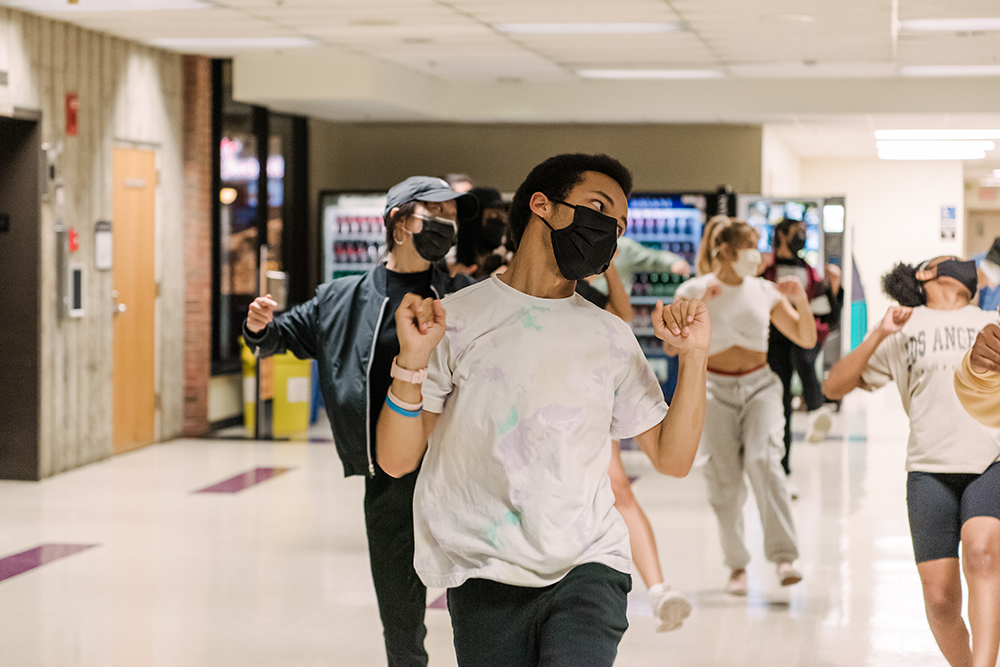
Prior to the pandemic, Major Def would meet at the UC three evenings a week. Even after their practices turned virtual, they continued working just as hard to put together concept videos in small teams. While Major Def plans on slowly getting back into the swing of things with the in-person semester, their energy remains just as contagious.
“When you’re really passionate about dance or you’re just looking forward to dancing with each other, the hours really don’t matter because they go by really quickly and you’re not even looking at the time,” says Huynh.
The club’s practices take place in an uplifting, supportive environment where teammates offer feedback to one another and embrace each other’s unique styles. From quick twists and turns, hand gestures, facial expressions, and smooth movements from head to toe, the dancers are precise and tell stories of their own.
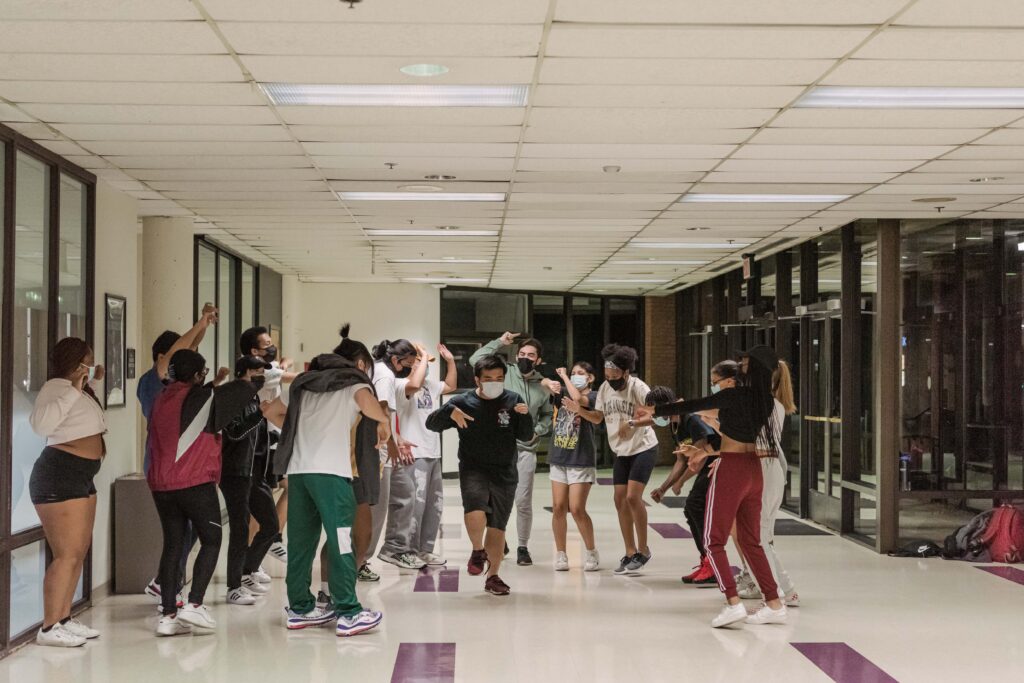
After practice, dancers form a circle and put their hands in for a chant before dismissal. Later, you might see the team stay back to chat with each other, show off their new choreography, or head out to grab some bubble tea.
“Even if you don’t see yourself growing in terms of dance, your other teammates can see it. And it’s really beautiful being able to see that progression,” Huynh says.
– Anna Lee ’22
Midnight Melodies
Fine Arts, Room 306
A single voice enchants you. Despite being faint, almost whisked away by the wind, the voice is clear. Another voice joins the first and then another until a whole group of voices are expertly switching from synchronization to harmonization, each moment a new voice coming to the forefront. Sonia Anger ’22, mathematics and psychology, with her clear soprano, blends with the talents around her.
The Cleftomaniacs made a name for themselves when they placed first in the 2018 Mid-Atlantic Quarterfinals at the International Championship of Collegiate A Cappella. When Anger got involved with the co-ed performance group her first year at UMBC, the club was the breath of fresh air she needed.
After a year spent serving with Americorps, Anger felt disconnected from her peers, but from the moment she auditioned, despite her own anxiety, she could see how welcoming and friendly the group was and she wanted to be a part of it. Anger talks about the Cleftomaniacs like the group is her own family. While they spend a lot of time together outside of club activities, performing is her favorite part.
When the group splits up to work on individual voice parts late at night, she frequently finds herself practicing in empty classrooms, hallways, and stairwells of ITE. Afterward, she often walks with her friends to the dorms or Late Night at True Grit’s only to continue singing.
“We would be singing outside of SUS [Susquehanna dorm] in the middle of December and people would be like, ‘You know you can go inside right?’ but we were stubborn and we just wanted to have fun,” says Anger.
– Charis Lawson ’20
Eyes to the Stars
UMBC Observatory and Lawn
It’s easy in an academic environment to keep your head in a book—or more likely, in front of a screen. The Astronomy Club, however, asks you to look up.
“I love taking walks at night around campus– it is very freeing.” says Tara O’Donnell ’24, physics. As she looked up into the night sky, O’Donnell—president of the Astronomy Club— and fellow members found solace in the vast cosmos. Despite loving the atmosphere of campus at night and the view of the stars and the moon, most of her first year at UMBC was virtual. “My experience was sitting in my room doing classes through Blackboard, so my opportunity to connect more fully with the UMBC community was through the Astronomy Club,” says O’Donnell.
Now the Astronomy Club once again meets in person, and their meetings range from discussing major space news like the Perseverance landing on Mars or making use of the telescope in the observatory on top of the Physics building to playing games like Jeopardy, watching movies, and hosting special guests and debates.
The Astronomy Club has maintained a thriving community. Late into the night, you can find O’Donnell and her friends looking up into the sky contemplating ideas as big as the universe itself.
– Charis Lawson ’20
Burning the Midnight Oil
Biological Sciences Building, Hua Lu Lab
When the sun has gone down, plants are just as active as they are during the day. Like humans, they have an internal clock that prompts responses to environmental stimuli such as light, temperature, and unwanted visitors like pathogens. If left unaddressed, these pathogens can be detrimental to plant health and reduce crop yield in agricultural fields. In UMBC’s Biological Sciences building, the members of Professor Hua Lu’s lab study the role of the circadian clock in plant defense against these outside invaders.
That explains the brown, cushiony sofa to the side of the room. Because students have had to monitor the plants every four hours for previous projects, Lu’s office has become the go-to snooze spot for overnight stays. Jessica Allison, a graduate student at the Lu lab, even remembers finding a sleeping bag under her desk after joining the team.
The plants that Allison and the other lab members use in their research, thale cress (Arabidopsis thaliana), seem to sit peacefully in the large chambers they’re stored in. But much more is happening beneath the surface of these wispy, flowering plants.
For her project, Allison regularly conducts a process called a luminescence assay where 96 thale cress seedlings are first planted into a well plate. The plates are then placed into chambers, where the plants are only exposed to light. Allison finally examines how the absence of dark conditions affects plants’ circadian clocks.
Even after the lab members have gone home, this process continues to run throughout the night. The next day, Allison uses a machine called a plate reader once an hour to check the plates for gene expression patterns—graphs that depict the activity of the plants’ internal clocks.
“We test a lot of genes like that, and we knock out some genes and see if it affects others. We let that run 24/7,” Allison explains.
For now, Allison hasn’t had to stay overnight to check up on the plants on a set schedule. But she expects to be making good use of the couch when the time comes.
– Anna Lee ’22
All-Nighters Welcome
Retriever Learning Center, Albin O. Kuhn Library
At 8 p.m. as the rest of the library closes for the night, students begin heading to the 24/7 Retriever Learning Center (RLC). The white lights of the RLC beam down on notebooks and bright laptop screens. Students clack away at their keyboards and scribble down notes from the formula-ridden whiteboards beside them. Some have earphones in, dedicated to finishing the assignment due at midnight, while others study all night in larger groups to tackle content for an upcoming exam.
Among them are information systems majors Ahsan Baig ’24, Devanshi Patel ’24, Emilien Tchuosi ’24, and Nazim Elliott ’22, who are working on a group project for their information systems class. Baig loves the fact that you don’t have to whisper here. The RLC’s whiteboards and portable chairs are also a plus, as the group mentions how practical they are for studying. Tchuosi especially appreciates having a place where she feels compelled to get work done.
“I come here on a daily basis just because it pressures me to study…. So when I come here, I actually study instead of watching YouTube videos,” Tchuosi says, eliciting laughter from her group mates.
Shawn Parker, a building manager at the library, is dedicated to making the RLC more secure and conducive to student learning. With students as a top priority, Parker works to provide accessible furniture and ensure students’ safety within the building. This was also students’ vision for the RLC when plans for an accessible learning space began in 2006. With support from the university, the overnight learning center became a reality.
Parker hopes that the center can continue equipping students with the resources to collaborate on all sorts of projects.
“It’s a brighter day for students when they’re listened to and understood. But most importantly, you have to hear what they’re saying to understand what they’re asking for. And that’s what I try to do best,” says Parker.
– Anna Lee ’22
*****
All photos taken by Marlayna Demond
Tags: Astronomy Club, Cleftomaniacs, Fall 2021, Humans vs. Zombies, MajorDefinition, Residential Life, Shuttle


